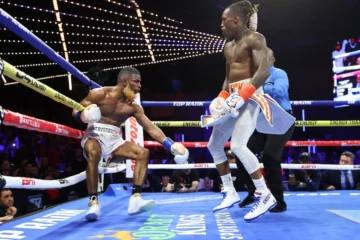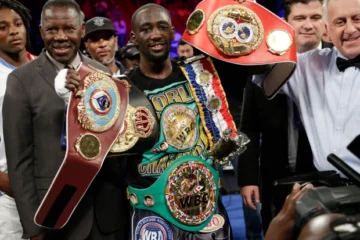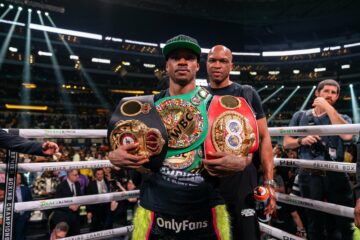Understanding Terence Crawford’s Greatness | A Beginner’s Guide to Terence Crawford
Terence Crawford, the three-division world champion from Omaha, Nebraska, who started boxing at the age of seven, might have one of the underrated resumes in boxing, simply because, his career has taken place during a major change in boxing, both in how we watch from TV to streaming and in-terms of being one of the major stars after Floyd Mayweather and Manny Pacquiao.
Crawford trained by famed Nebraska boxing coach Midge Minor as a child, amassing an amateur record 58-12 with wins over Mikey Garcia, Stan Martyniouk, Carlos Molina, Danny Garcia, Miguel Angel Gonzalez, Diego Magdaleno. Crawford’s defining amateur performances were a 2006 lightweight bronze medal at the U.S. Nationals, a silver medal at the national golden gloves in 2006, a gold medal at the U.S. blue & gold championship, a gold medal at the U.S. PAL in 2006, a bronze medal at the 2007 U.S. National Championship, and making it to the 2007 Olympic Trials only to lose to Miguel “Silky” Gonzalez.
Crawford amassed a great amateur career, but was still behind others like Jerry Belmontes, “Silky” Gonzalez, and others from his class, as they were seen as more of “blue-chip prospects” at that time as opposed to Crawford.
In 2008, Crawford was shot in the head after a dice game, this has been well documented in some of his early television fights.
Crawford turned professional under TKO Boxing Promotions, a company ran by Chris Middendorf. Crawford, a top-talent fought most of his early bouts on club shows, looking to obtain a record that could put him a place to earn lifechanging money.
As a professional, he worked with Brian “Bo-Mac” McIntyre, a former heavyweight boxer who fought Eric “Butterbean” Esch at one-time, coach Red Spikes, and coach Tuto, forming a symbiotic relationship of collaboration for Crawford to maximize his own skill and not their own ego. Part of the genius that is Terence Crawford is the selflessness of his team, you might not know a lot about some of the members of his team, because they teach and work, they’re not on the frontline talking, they’re on the frontline doing. Being from a small market boxing city of Omaha, Nebraska, it really feels like this concerted effort was in order for them to raise up and be successful, they’d have to do it as a team, which in our world of apps, financial freedom and other constructs, is seemingly foreign at times.
In 2011, Top Rank Inc would take over Crawford’s contract under a Promotional Rights Agreement with TKO Boxing Promotions, who were having financial issues at the time and now no longer exist in that iteration of the company.
Crawford’s only early fight that you can find on YouTube is against Derick Campos, in a baseball field in Denver, on a “Mile-High” Mike Alvarado undercard, when Top Rank had more regional-based shows, and broadcast on Spanish language television in the United States.
This bout is interesting because in hindsight you can see the traits that make Crawford great, but that is with context. If you look at it, during that time, he stopped his opponent while being patient, tactical, so forth and so on. Crawford was a high-level fighter, being brought in to do training camps with world champions such as Timothy Bradley Jr., but like so many fighters in his spot, was void of an opportunity to get a massive raise in salary, as Crawford was set on the undercard bouts against opponents who didn’t stand out to the fans.
Enter the Breidis Prescott fight a/k/a Crawford’s HBO debut.
Terence Crawford took a fight on less than two week’s notice and moved up to super-lightweight to replace Khabib Allakhverdiev, who was coming off a very good fight against Jessie Vargas, to face Columbian puncher Breidis Prescott, best known for knocking out Amir Khan, early in Khan’s career. Crawford, a slight underdog by some heading into the fight put on a virtuoso performance winning every round and boxing from both the orthodox and southpaw stances, as well as staying composed and boxing a big puncher like Prescott.
The fight also got a major assist as it was the co-main event to one of the most highly anticipated rematches at the time, Brandon Rios versus Mike Alvarado II, as the large viewership exposed Crawford’s talents to the world.
Crawford would move down to lightweight stopping Alejandro Sanabria and win a decisive ten-round decision over Andrey Klimov before getting his first world title by defeating Ricky Burns in Glasgow, Scotland.
Context needs to be added here. Burns was a fighter, who was beloved in the U.K., but was infamous for favorable scorecards around the world, as Ray Beltran had broken Burns’ jaw and perhaps his will, but was somehow awarded a draw. Burns had held the WBO lightweight belt for four years, and was looking like a hard bout for anyone as his mauling style and home-field advantage felt as though it would take a special fighter to overcome the odds. Fighting Burns was essentially fighting the crowd, the system, and everything put in front of you, not just a twelve round fight.
This is the overlooked part of Crawford’s career. Crawford, and a group of his close friends, went overseas into the world champions backyard, not having all the creature comforts they were used to, and decisively defeated Burns, who by the late-middle rounds found himself more often than not, on the ropes. The focus of Crawford walking out to the ring for this very fight, shows just how much this meant to him, as his focus, and determination has not been as evident, and more so, Crawford has not been as vulnerable since, as Crawford is one of the fighters who are good at concealing who is.
The celebration amongst Crawford, his team and Top Rank matchmaker Brad Goodman once the fight is over and Crawford is announced the victor, is one of these iconic moments as it is a fight that will soon be forgotten, but will symbolize the start of an era, Crawford controlled, as Crawford even did a backflip in celebration of achieving a lifelong dream.
Crawford would bring back the WBO lightweight world title to Omaha, Nebraska, and make his first world title defense against former 2004 flyweight Olympic gold medalist Yuriorkis Gamboa at the Centurylink Center. This might be Crawford’s crowning achievement as a prizefighter, struggled in the early parts of the bout with Gamboa’s speed, and awkward jump in and out style, as timing is a major strength of Crawford’s that Gamboa nullified early.
This bout started the mythos of Crawford’s three-round adjustment. Crawford had three sub-par rounds, and then adjusted, switching to southpaw and catching Gamboa coming in with a lead right hook. In a modern-day classic, that saw Gamboa hit the canvas in the fifth, eighth, and twice in the ninth round, Crawford went from being the decision tactical guy to the finisher, the dog, the guy that if you showed weakness Crawford would bully you until you break. Not that Crawford was not that before, but having a world title and being at home, this just became more evident, and the confidence for who he grew exponentially. Crawford was a capital G guy now.
Crawford would make one more defense of his WBO lightweight world title against Ray Beltran, whom he would defeat soundly by decision, before moving up to the 140 lbs division of super lightweight.
In Crawford’s first bout at 140 lbs, Crawford would fight for the vacant WBO super-lightweight world title against tough former prospect Thomas Dulorme. Dulorme, whom Roy Jones Jr. on the commentator team, foreshadowed in his broadcasting stated, ‘Dulorme is a fast starter, who fades quick’. After Dulorme won four if not five of the rounds of the bout, Crawford picked up the pace and stopped him in the sixth, nearly on cue to Jones Jr.’s thoughts on the broadcast.
What was not discussed was Dulorme, who at one time was an HBO future star before being knocked out by Luis Abregu, and was coming off a win over a solid fighter in Karim Mayfield, and was being heavily avoided despite his high world ranking.
Crawford would make two more defenses of his title against #1 contender Dierry Jean and also against Hank Lundy, stopping both of them.
This would lead to a SUPER-FIGHT with Viktor Postol.
Postol, who had won the WBC world title against Lucas Matthysse, stopping Matthysse in the tenth round. The bout was viewed as a mega-fight and even was placed on pay-per-view as the bout served as a unification of two world titles and looked to potentially get Crawford in a place to be a major name.
Two things happened, Crawford won dominantly, and the pay-per-view did lousy numbers.
As for the in-ring stuff, Crawford had his three-round adjustment per usual, before dropping Postol twice in round five with the first being the very first punch of the round. Crawford also lost a point for punching behind the head in the eleventh. The ugly aftermath of this was reported per ESPN, 50,000 PPV buys, which was well short of what was hoped for.
Crawford would return two more times on HBO defeating John Molina Jr., who came in last-minute for the bout, and missed weight as well as 2008 Olympic gold medalist Felix Diaz, both of whom he stopped.
It is important to note HBO and Crawford’s promoter, Top Rank, had major issues especially after an Oscar Valdez versus Miguel Marriaga fight became a Top Rank PPV, as it appeared no other network showed interest, and at this time, Top Rank was mostly on HBO and Telemundo with the ‘Solo Boxeo’ series. Top Rank partnered with ESPN in August of 2017.
Crawford’s first fight on ESPN was a historic one as he defeated Julius Indongo, to do something never before done, hold all four world titles at the super lightweight division, as Indongo held the other two, Crawford didn’t have. Crawford stopped Indongo in three rounds as Crawford made the holder of two world title belts look vastly inferior to his talents in the ring.
After winning all the major belts at the 140 lbs division doing something that only Bernard Hopkins and Jermain Taylor had done prior in holding all the world titles at the same time, Crawford went to welterweight and fought for the world title in his first fight.
Crawford faced Jeff Horn, the man who had just beaten Manny Pacquiao, as Crawford handed out one of the nastiest beatings I had ever seen in person, pummeling Horn for nine rounds until a merciful stoppage. Crawford punched through Horn’s chest early and often as the sound of the punches in the MGM Grand Arena were loud and vibrant.
With this win, Crawford became a three-division world champion, yet due to the politics of boxing, was now seeing fighters in his same weight class with rival networks and promoters, not looking to fight him as Crawford’s skill didn’t equal the money offered. In short, fighters could fight easier opponents for the same money as Crawford, and perhaps prolong their career as opposed to potentially shorten it. The risk of Crawford’s skill sadly did not match the reward in purse.
His following bouts are underrated as Jose Benavidez Jr., a very good fighter, gets grossly underrated when brought up on Crawford’s resume as Crawford stopped Benavidez Jr late in the twelfth in a competitive and action affair.
Crawford went to pay-per-view for the second time of his career to face Amir Khan doing a little over double what he had done, by netting 125,000 buys for his pay-per-view, making his current tally in terms of pay-per-view buys at 175,000 for his career.
The Khan fight was a good name for his record, as Khan is a legend, but it is also, one that viewers knew the outcome before the fight had begun. Crawford dropped Khan in the first round and stopped him in the sixth. It was about as one-sided as a high-level fight could be, and one that you wish as a fan could’ve been a bit more competitive as this felt like a prime Terence Crawford.
Crawford’s last bout was against Egidijus Kavaliauskas a/k/a The Mean Machine, a big puncher, who comes forward, but saw his success from the club shows diminish when dealing with fighters at the next level, as simply applying a lot of pressure in a fight was not going to work. Kavaliauskas coming off a close fight with Juan Carlos Abreu, knocking out Roberto Arriaza, and a draw with “The New” Ray Robinson, having about as little momentum going into a world fight as you could have. That being said, Kavaliauskas fought the fight of a lifetime, giving Crawford some trouble as Crawford stubbornly fought on the inside, in a seemingly even fight until, Crawford dropped Mean Machine in round seven, and stopped him in ninth.
So what is Crawford’s legacy?
Crawford is a tremendous boxer, who had a solid punch but was meaner than most modern fighters. Crawford had little to interest in being friends with media or other fighters, he wanted to win, and should his joy at his craft in the ring.
Crawford’s legacy will be that of his awards, many, and the six-world titles he has won across three weight classes. Crawford, who will more than likely go down as the best fighter to come out of Nebraska, will also be defined by if he can get a fight that interests the public. Crawford’s legacy is set, as he is a hall-of-famer, but now it is about to what extent is his name muttered through the history of boxing, and how is it remembered.
Crawford will hopefully fight Errol Spence Jr., and if not Spence Jr., then one of these young up-and-comers like Jaron “Boots” Ennis or Vergil Ortiz Jr., prior to calling it a day. Crawford needs a worthy foe, as, despite all of his success, part of his legacy will also be his talent not completing resonating with a fanbase based upon ticket sales in markets outside of Nebraska and New York, as well as pay-per-view buys.
Terence Crawford is currently 36-0 with 27 wins by way of knockout.
You can listen to our complete deep-dive on Crawford right here.





